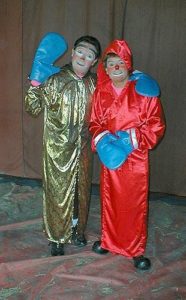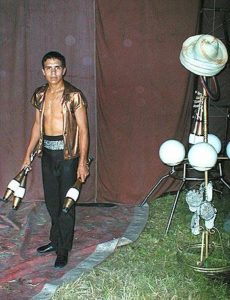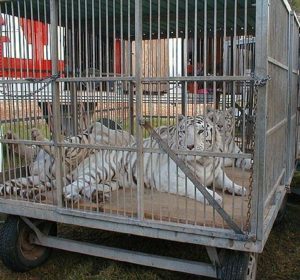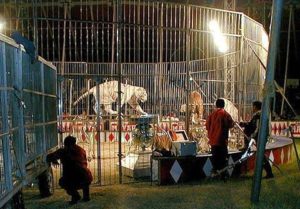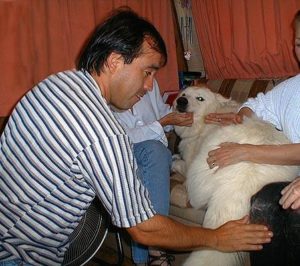He walks around within the confines of an enclosed steel cage which he shares with eight 500 pound tigers. The cage is roughly 25 feet in diameter and 12 feet tall, composed of interlocked sections and hastily put together between acts of the Hermanos Mayar circus. A few of these massive creatures roar at him and bare their teeth as he strides confidently among them. He carries no holstered pistol and doesn't use a whip. In his hands are two long leather crops which he uses to guide the animals through their paces. He occasionally nudges one of the wild cats but rarely, if ever, hits one. This is part of his philosophy of wild animal management. In his early 40's, he has been working with wild animals, mostly lions and tigers, for 22 years.
Although in person the tiger trainer, Nestor Fischer, is physically small and unprepossessing, working in the cage surrounded by constant danger from the teeth and paws of his feral charges his presence is nothing if not commanding. In this highly charged environment he seems bigger than he appears to be up close. He tells me with a gentle smile that he must keep the tigers convinced at all times that he is the dominant one, the alpha male of the group. If he allows them to think otherwise, he can expect to be attacked. He seems a paradox: an unusual combination of steely internal control and a thick mantle of external tranquility.
The tigers he works with include 6 white Siberians and 2 Bengals. The white Siberians, with eerie blue eyes, dark stripes and creamy white in-between, are a result of a spontaneous genetic mutation in the mid 1960's in the wilds of Africa. Subsequent cross-breeding produced a significant number of these beautiful animals. Unfortunately, as the tiger master points out, the intense inbreeding has resulted in a tiger that is less active, less intelligent and prone to a panoply of health problems. The Bengals, brilliantly colored in the more traditional hues, are the ones Mr. Fischer always has to be wary of. Their intelligence is greater than that of the "whites" and they can be more aggressive in challenging his status in the cage.
As a child in Chile, Nestor Fischer spent a lot of time watching and helping his German grandfather train wild animals. His parents objected to his exposure to such danger and for a long time his grandfather enabled him to spend time around the wild cats without his parent's knowledge.When Nestor was a teenager, his grandfather finally realized he had a talent for training wild animals. He told Nestor it was time to stop hiding this from his parents and to get on with his professional training.
During his years of striving to master this esoteric art, he read about the famous and innovative German wild animal trainer Carl Hagenbeck whose work, he says, imparted to him great insights into the psyches of wild animals. Hagenbeck was the first of the great trainers to develop techniques that avoided painful punishments to control animals; instead Hagenbeck used and promoted methods of positive reward. Nestor adopted these teachings for his own work. In addition to Mexico, Nestor has performed in circuses in various countries including Chile and Brazil.
During the interview, I found his knowledge of animal behaviour impressive. He emits an aura of inner strength and controlled intensity, yet speaking with him is relaxing and he puts one at ease with a contagious smile. He is divorced with a lovely second wife, Luciana, from Brazil who travels with him on the road. She left her job in Brazil as a Veterinary Microbiologist to be with him. Her Spanish is liberally sprinkled with Portuguese. Sharing their trailer with them are a massive pure white 160 pound Wolf and Alaskan malamute cross, Baron; a 6 pound toy poodle; and an 80 pound 2 year old orangutan, Bart, who is beloved by all of the circus workers and is somewhat of a circus mascot. Baron is friendly and affectionate in spite of his massiveness. As Nestor points out Baron has the teeth of a wolf, not a dog. The orangutan, Bart, is almost like a child to the Fischers and has to be treated like one because of his mischievous playfulness combined with his powerful simian limbs which can wreak havoc in their trailer. Bart looks to Luciane' as his mother and goes to her when he is upset or tired. When he gets too playful, only Nestor can control him adequately.
Nestor's tiger act is currently the premier act of the Hermanos Mayar Circus. His contract will be over at the end of the year. However, there is no shortage of offers to work in any one of a number of circuses in various parts of the globe.
According to Ernesto Medina, the circus manager, Hermanos Mayar is one of the top five Mexican circuses. The circus travels in an ongoing circuit around Mexico and usually goes back to the same towns and cities each cycle. They may perform for 2-3 months around Mexico City, Puebla and Monterrey, but only 5 days in small towns like Moroleon in Guanajuato.
As the circus moves from place to place through various parts of Mexico, the acts are occasionally changed. This allows the circus to keep functioning throughout the year and permits some performers to take vacations while others are working. It also serves to keep things fresh and new for audiences. They travel using 10 of their own tractor trailers. The performers and workers live in their own trailers with their families although many with school age children leave the children at home with grandparents or other family members so as not to interrupt their education, only to be reunited with them for vacations. One notable exception is the trailer of Jose Pena Lopez, the motorcyclist who performs within the "Globe of Death", a massive round structure of iron struts.
Jose's act includes a male colleague who pedals a bicycle around the inside of the globe and Jose's two daughters who ride mini-motorcycles within the globe while their father spins circles dangerously among them. The 2 daughters aged 9 and 11 wear helmets and football-type shoulder pads while working. They live in the trailer with Jose and his wife. Poised young ladies, they seem completely unaware of their importance as major circus performers. They underwent 3 years of training before Jose felt they were ready to perform in the act.
The circus has 30-40 regular employees at any given time plus 15 or more performers. In each town or city where the circus performs, 15-20 extras are hired to help out. Ernesto, the Manager, has 3 assistants who aide in handling the logistical nightmare of coordinating such a sizeable operation. In addition to scheduling and public relations, permits for each town and city must be obtained in advance and arrangements must be made for water and initial electrical connections to allow the workers time to get the circuses own generator running. According to Ernesto, it takes 1½ days to set-up but only 1/2 a day to break the circus down in preparation for getting back on the road.
In addition to the 8 tigers, the circus travels with a troupe of trained dogs, a pair of sea lions and the orangutan. The tigers are transferred from their cages every other day and the cages are thoroughly cleaned. They eat 4-6 large chickens a day (dead ones, of course). Nestor, the tiger trainer, quotes a veterinary text assuring us that chicken can keep the tigers healthy and their appearance bears him out. He notes with a look of amusement that they are sometimes fussy and prefer the fattier chickens with a golden-yellow color, more easily obtained in certain areas of the country.
Jorge Tarasco, the sea lion trainer, has only been working with the two sea lions for a few months. Their thoroughly enjoyable antics when performing belie this fact. Mr. Tarasco is a handsome man who like most of the performers I spoke to seemed intelligent and very knowledgeable about his animals. He looked like he could be an actor in a T.V." telenovela" or in a movie. The sea lions travel in an air-conditioned trailer with a built-in water tank. When the tank is refilled after cleaning every other day, measured amounts of salt are added to the water to better simulate their natural environment. On the road, the tank water level is lowered to give them more comfort. They appear happy and well-adjusted. Their black coats are shiny. They also appear healthy and well cared for. When following Jorge from their trailer to the performing tent, they were downright eager to get started.
The circus was founded in Puebla in 1949 by the Gonzalez brothers. Eventually, two of the three brothers broke off to form and run their own circus. Vicente Gonzalez stayed with this one and is the current owner with his sons. One of his sons is the ringmaster.
The Hermanos Mayar Circus also boasts a high wire act performed by 2 young Mexican men who hail from Monterrey. Four years ago, they won a competition involving circuses all over Mexico. After watching them work, high up in the big top, with no safety lines or net, I asked the manager about them. He told me they practice assiduously every day, concentrating on any part of their routine they feel insecure with. According to him, tightrope walkers always keep themselves in top physical condition and practice controlled loss-of-balance and controlled falls in which they catch on to the wire with their hands or legs to prevent them from plummeting downward in free fall. They continuously use an imaginary number system to gauge their safety while on the high wire.
If at any given time during their performance they estimate that there is a 60% or better probability that they are not about to lose control, they go on with their act. If they perceive that the odds of their not falling are less than 60%, they purposely initiate a controlled fall. In the case of these young men who work sans safety net, they catch the wire with their hands. Sr. Medina brought the conversation to the famous Flying Wallendas, a world-class tight wire act of times past, which performed in Mexico many times. He said there is a story that is believed by circus people in Mexico that the elder Wallenda who died falling from the high wire did it on purpose, actually planning his suicide this way. This belief came about because of the way tight-rope walkers normally maintain control of their actions while performing.
The circus has 2 clowns. They are both Mexican. The younger man is 32 years old and comes from the state of Michoacan.. At one time he wanted to be an actor and was studying drama in the university when a friend asked him if he would be interested in being a clown. He has loved his work ever since. The older of the two is 43 and is from Mexico City. He comes from a family of circus clowns which included his father and several uncles. Their acts are much in the style of slapstick and verbal interchange in Spanish innuendo much of which I didn't understand but which inspired infectious laughter from the audience. They projected the feeling that they were enjoying entertaining the audience. As they chatted with me between performances, I was taken by their articulation, intelligence and meticulous appearance. Their outfits for each act were spotlessly clean.
The Hermanos Mayar Circus is a one ring affair much in the Mexican circus style. I had the pleasure of attending a performance in Morelia in a large field across from Walmart and Home Mart. The "big top" tent was held up with modern metal towers and was open around the perimeter. The bleachers under the tent felt solid underfoot. As with most modern Mexican circuses, a sound system is used instead of a live band. During the intermission, one of Nestor Fischer's assistants walked around the ring with Bart, the orangutan, allowing spectators to touch Bart and vice versa delighting the children "of all ages". The dog trainer, who is referred to as Professor Medina, came out dressed in a clown costume and sold cotton candy. Young children were invited out of the audience to have their pictures taken with costumed characters from "Toy Story" and Mickey Mouse. The lack of formality and the attention to children are two of the endearments of Mexican circuses.
All in all, they present an enjoyable show.

